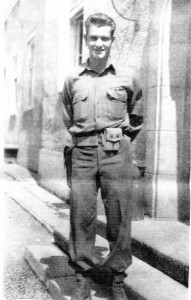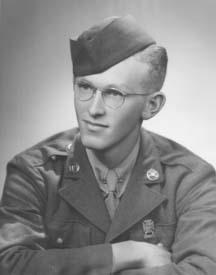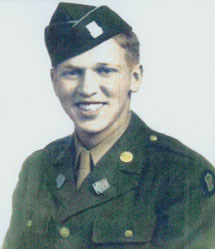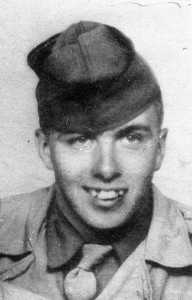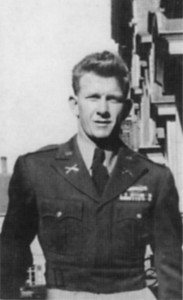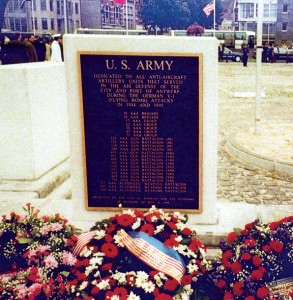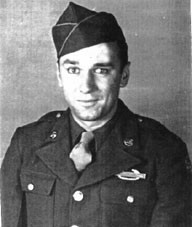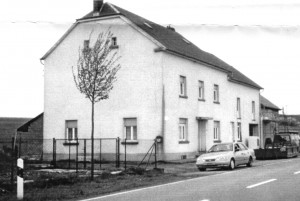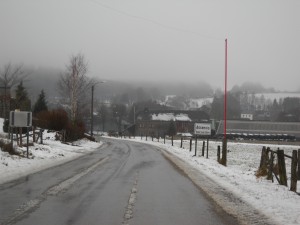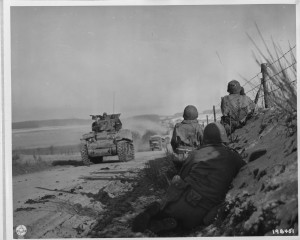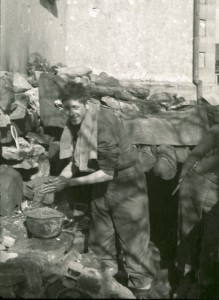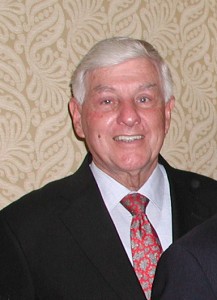
987th FIELD ARTILLERY BATTALION IN WORLD WAR II (From D-Day in Normandy to VE-Day in Czechoslovakia)
by Harlan Lincoln Harner, 987th FAB
The 987th Field Artillery Battalion, minus its 155mm self-propelled guns, left Camp Bowie, Texas 17 February, 1944, and five days later arrived at Camp Shanks, New York, where it prepared for shipment overseas.
On 13 March, the 987th sailed from New York Harbor with several thousand other servicemen and women aboard the converted French luxury liner He de France, bound for an unescorted crossing of the North Atlantic. After outrunning several German U-boats, the He de France, after nine days at sea, arrived at Greenock, Scotland on March 22nd.
Upon debarking, the battalion traveled by rail to Camp Bulwark at Chepstow in the south of Wales, where it remained just three weeks before being sent to Clacton-on-Sea, Essex, on the North Sea coast of England. At that location, it worked with the British 50th (Northumbrian) Division, and waterproofed its vehicles, including its M-12 155mm self-propelled guns mounted on Sherman tank chassis that it received on 2 May, all in preparation for the invasion of Normandy, France.
The First Party, 22 officers and 276 enlisted men, the personnel and equipment needed for operations on the “first wave,” moved 30 miles to Camp R7 at Suffolk, just north of Ipswich, for preliminary briefing, then on 29 May to R6 12 miles south of Ipswich, and on June 1 to Felixstowe, where it loaded onto four LSTs (Landing Ship Tank).
On 5 June, the battalion’s advance party sailed from Felixstowe, past the White Cliffs of Dover and into the English Channel. It arrived on the Normandy coast near La Riviere Harbor at 2000 on D-Day, June 6. Rough seas prevented landing at H hour plus 12, as originally planned. There was a night of fireworks as two Luftwaffe planes attempted to attack along the beach, were fired on from ships and forces on the beachhead, and a British battleship and other naval craft fired on enemy shore batteries and other targets inland. At daybreak, about 30 captured German soldiers were brought aboard and were guarded by members of the 987th prior to their being taken to a prisoner of war camp in England.
The battalion’s first party landed at King Green Beach in the British Gold Beach sector, about 20 miles east of the U.S. Army’s Omaha Beach, in late morning of 7 June, and took up its first combat position three miles inland, one mile south of Ryes, Normandy, attached to the British 50th (Northumbrian) Division. The war had begun for the 987th. The rest of the battalion came ashore in the next few days.
The next move for the battalion was to the outskirts of Bayeaux where it was assigned to 5th AGRA (Army Group Royal Artillery), British 2nd Army. The 987th supported the British forces in their effort to capture Caen. On 30 June 1944, the 987th reverted to U.S. Army command and was attached to V Corps, First Army as corps artillery. In short order, temporary assignment to VII Corps sent the 987th racing up the Cotentin Peninsula to the outskirts of Cherbourg. But when informed it was not needed it quickly returned to the V Corps sector.
The 987th supported the 2nd Armored Division in the 27 July breakthrough at St. Lo and its drive southwest to the coast. The battalion then was part of the race east across France in a major effort to close the Falais Gap and surround numerous thousands of German soldiers to prevent their escape. Many thousands were captured, but other thousands were able to flee east toward the Fatherland. Then, it was on to the French capital. On 30 August the battalion entered Paris with the 5th Armored Division to wild celebration by French citizens dressed in their finest. There were bouquets of flowers and kisses from French madamoiselles. German snipers still in the city fired on the parading troops, but they were quickly flushed out and killed or captured.
Once through Paris, the 987th moved northward with the 5th Armored for that division’s September push through Northern France into Belgium and then to the south and east through Luxembourg and into Germany. With the 5th Armored, the 987th‘s 155mm self-propelled guns were the first heavy artillery to crack the Siegfried Line. A heavy German counterattack on 19 September forced the battalion, as part of a combat command of 5th Armored and 28th Division troops, from Wallendorf back to Cruchten, where they came under heavy enemy fire, and then back into Luxembourg.
Numerous times the 987th‘s guns performed direct fire on Siegfried Line pillboxes, well-dug-in, thick, reinforced concrete bunkers manned with machine guns and heavy anti-tank weapons. It knocked out eleven pillboxes in its first penetration of the Siegfried Line, and overall, including a later penetration, the 987th knocked out about 100 of them.
Platoons and even individual guns of the battalion’s batteries were often separated, supporting different divisions. For instance, at one time one gun of B Battery supported the 8th Division at Hurtgen, while one platoon of A Battery supported the 104th Division at Eschweiler, another platoon of A Battery supported the 1st Division south of Heistein, and the remainder of the battalion was at Rotgen in support of the 78th Division.
When a German counter-offensive struck on 16 December 1944 in the Ardennes, opening what became known as the Battle of the Bulge, the 987th‘s gun batteries were separated, supporting various units at Hurtgen, Krinkelt and Elsenborn. On 20 December the battalion moved to a position near Ster, Belgium, the first time the battalion had been together since 8 October 1944.
It was at this time that the battalion sighted the first German “buzz bombs,” self-propelled flying bombs, which flew over the battalion’s position west of Malmedy on their way to Liege, Belgium. One buzz bomb’s motor cut out prematurely and it landed and exploded on a road less than 100 yards from a railroad station being used as B Battery headquarters. The explosion blew out the windows and knocked down the ceilings in the depot, but it resulted in only two persons being slightly injured from flying debris.
The 987th‘s activity in the Bulge found it supporting the 1st, 2nd, 9th, 28th, 30th and 104th Infantry Divisions and the 7th Armored Division in the drive to take St. Vith. During December 1944, the 987th‘s guns fired 7,108 rounds in 271 missions, the most rounds of any month in combat, and nearly 800 more than the previous high in June 1944. The Battle of the Bulge didn’t end until January 24, 1945
Early March, 1945 found the 987th at Remagen on the Rhine River in Germany helping defend the Ludendorf Railroad Bridge to prevent it from being blown up by retreating German forces. On 9 March, one A Battery gun attached to the 9th Division crossed the Remagen bridge, the only heavy artillery to do so and the first heavy artillery across the Rhine. By 21 March, the entire battalion had crossed the Rhine on pontoon bridges.
It was at Remagen that members of the battalion first saw German jet planes, which attempted to knock out the bridge to deny its use to U.S. troops. One of our 50-caliber machine guns helped shoot down one of the enemy planes. The German pilot who parachuted was captured by B Battery members.
After crossing the Rhine, the 987th raced across Germany with First Army, then with General Patton’s 3rd Army. It moved as far East as the vicinity of Leipzig in eastern Germany. At Werben, near Leipzig, the battalion received its heaviest shelling of the war when German 88mm and 128mm guns of the Leipzig anti-aircraft defense ring turned on our big 155s. On 26 April 1945, the battalion’s two liaison pilots flew two reporters to Torgau on the Elbe River to cover the meeting of the Americans with the Russians.
From Leipzig, the battalion turned south, and on 5 May, crossed the border into Czechoslovakia. On the 7th, B Battery moved with the 16th Armored Division spearhead to capture Pilsen, home of Pilsner beer and the Skoda Armament Works. It was on the tankers’ radios the next day, the 8th of May, that B Battery’s men heard the BBC broadcast that the Germans had surrendered, and the war was over. There was no Pilsner beer to be had, but before leaving Pilsen, a number of B Battery men “liberated” a warehouse full of German brandy, backed up a 2 1/2-ton 6X6 truck and loaded up. The battery commandeer made sure the brandy was shared with the rest of the battalion, which was just outside of the city. The last round fired in combat by the 987th was on May 4th by C Battery on the town of Stiebenreith, Germany.
From 31 May to 1 July, 1945, the 987th was on security guard and road patrol at such places as Mies, Heiligen, Hostice and Horazdovic, Czechoslovakia. It guarded numerous prisoners, including 6,000 members of the SS, and during May, the battalion captured 122 enemy soldiers.
For its part in the war that subdued Nazi Germany, the 987 FA Bn was awarded the Normandy Invasion arrowhead and five battle stars for all the European campaigns-Normandy, Northern France, Ardennes, Rhineland and Central Europe. From 6 June 1944 to 31 May 1945, the 987th in whole or in part, was assigned, attached to, or in support of the following units:
Armies—Second British, First US and Third US Corps-30th British; III, V, VII and XVIIIAB US Infantry Divisions-British 49th and 50th, and US 1st, 2nd, 4th, 8th, 9th, 28th 30th, 69th, 78th, 97th, 99th and 104th. Armored Divisions-US 2nd, 5th, 7th, 9th, 16th and British 7th Airborne Divisions—82nd Field Artillery Groups-5th Royal Artillery, US 187th, 188th 190th, 258th, 351st, 406th and 408th.
The 987th traveled some 1,850 miles from the Normandy beachhead to Czechoslovakia, fired 45,058 rounds, including 1,517 captured enemy projectiles, had 9 men killed in action and 74 wounded, and captured 256 enemy soldiers. Air Ops flew 306 sorties totaling 580 hours. One of the battalion’s observation planes was shot down by Messerschmidts in France.
Men of the 987th were awarded one Distinguished Service Cross, 11 Silver Stars, 90 Bronze Stars, 77 Purple Hearts, 16 Air Medals, one Croix de Guerre avec Palms (French), one Distinguished Service Order (British), and one Military Cross (British). Two sergeants were given battlefield commissions.
Though it was heavy artillery, the 987th‘s mobility resulted in its often being on the front lines with the infantry. One U.S. general in the Hurtgen Forest, who had never seen the M-12 with its big 155mm gun that could fire and move quickly, called it our secret weapon after he observed it in direct fire on enemy fortifications.
The 987th Field Artillery Battalion was one of numerous individual units in the European Theatre that fought courageously, with little time out of the front lines but got little of the credit they deserved because they were not part of a specific division. But the men of the 987th were there when they were needed, impressed not only the enemy but also the American units they supported, and they contributed mightily to victory over an enemy that had brutally killed and enslaved millions.

